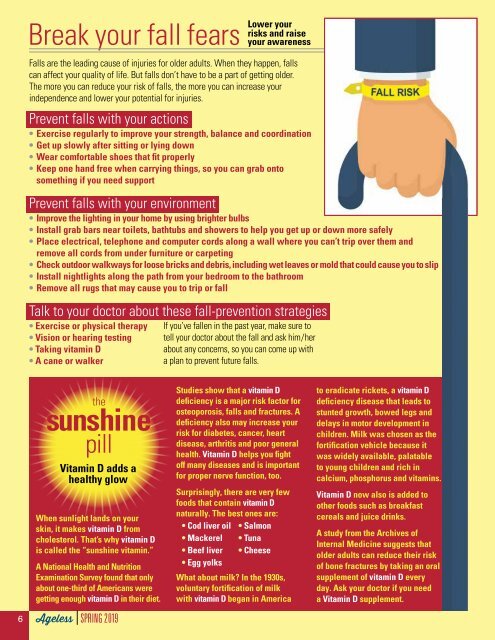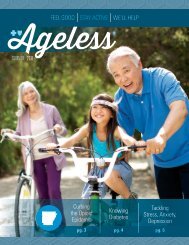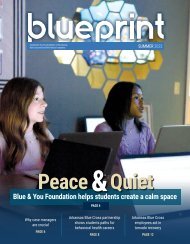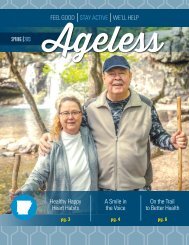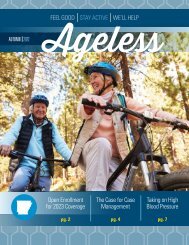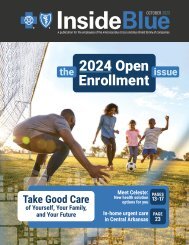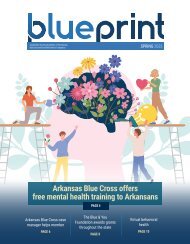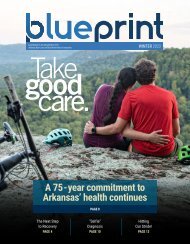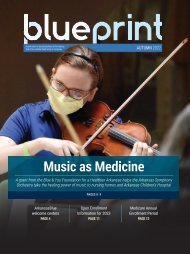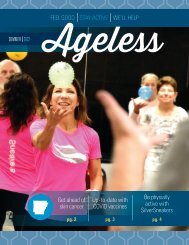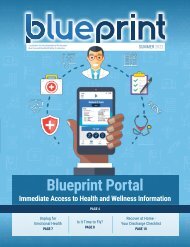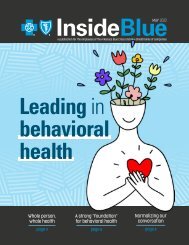Ageless SPRING 2019
You also want an ePaper? Increase the reach of your titles
YUMPU automatically turns print PDFs into web optimized ePapers that Google loves.
Break your fall fears<br />
Lower your<br />
risks and raise<br />
your awareness<br />
Falls are the leading cause of injuries for older adults. When they happen, falls<br />
can affect your quality of life. But falls don’t have to be a part of getting older.<br />
The more you can reduce your risk of falls, the more you can increase your<br />
independence and lower your potential for injuries.<br />
Prevent falls with your actions<br />
• Exercise regularly to improve your strength, balance and coordination<br />
• Get up slowly after sitting or lying down<br />
• Wear comfortable shoes that fit properly<br />
• Keep one hand free when carrying things, so you can grab onto<br />
something if you need support<br />
Prevent falls with your environment<br />
• Improve the lighting in your home by using brighter bulbs<br />
• Install grab bars near toilets, bathtubs and showers to help you get up or down more safely<br />
• Place electrical, telephone and computer cords along a wall where you can’t trip over them and<br />
remove all cords from under furniture or carpeting<br />
• Check outdoor walkways for loose bricks and debris, including wet leaves or mold that could cause you to slip<br />
• Install nightlights along the path from your bedroom to the bathroom<br />
• Remove all rugs that may cause you to trip or fall<br />
Talk to your doctor about these fall-prevention strategies<br />
• Exercise or physical therapy<br />
• Vision or hearing testing<br />
• Taking vitamin D<br />
• A cane or walker<br />
If you’ve fallen in the past year, make sure to<br />
tell your doctor about the fall and ask him/her<br />
about any concerns, so you can come up with<br />
a plan to prevent future falls.<br />
the<br />
sunshine<br />
pill<br />
Vitamin D adds a<br />
healthy glow<br />
When sunlight lands on your<br />
skin, it makes vitamin D from<br />
cholesterol. That’s why vitamin D<br />
is called the “sunshine vitamin.”<br />
A National Health and Nutrition<br />
Examination Survey found that only<br />
about one-third of Americans were<br />
getting enough vitamin D in their diet.<br />
6 <strong>Ageless</strong> <strong>SPRING</strong> <strong>2019</strong><br />
Studies show that a vitamin D<br />
deficiency is a major risk factor for<br />
osteoporosis, falls and fractures. A<br />
deficiency also may increase your<br />
risk for diabetes, cancer, heart<br />
disease, arthritis and poor general<br />
health. Vitamin D helps you fight<br />
off many diseases and is important<br />
for proper nerve function, too.<br />
Surprisingly, there are very few<br />
foods that contain vitamin D<br />
naturally. The best ones are:<br />
• Cod liver oil • Salmon<br />
• Mackerel • Tuna<br />
• Beef liver • Cheese<br />
• Egg yolks<br />
What about milk? In the 1930s,<br />
voluntary fortification of milk<br />
with vitamin D began in America<br />
to eradicate rickets, a vitamin D<br />
deficiency disease that leads to<br />
stunted growth, bowed legs and<br />
delays in motor development in<br />
children. Milk was chosen as the<br />
fortification vehicle because it<br />
was widely available, palatable<br />
to young children and rich in<br />
calcium, phosphorus and vitamins.<br />
Vitamin D now also is added to<br />
other foods such as breakfast<br />
cereals and juice drinks.<br />
A study from the Archives of<br />
Internal Medicine suggests that<br />
older adults can reduce their risk<br />
of bone fractures by taking an oral<br />
supplement of vitamin D every<br />
day. Ask your doctor if you need<br />
a Vitamin D supplement.


